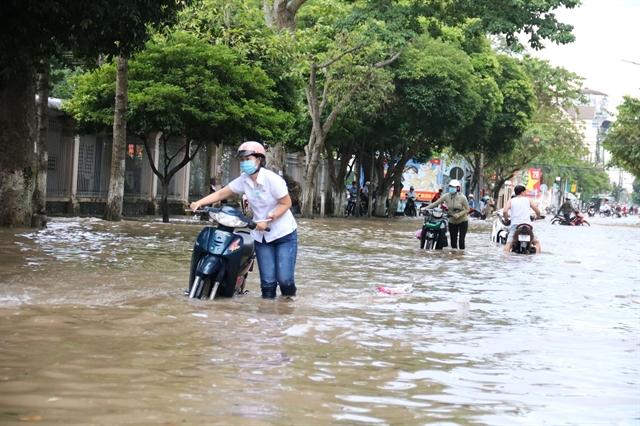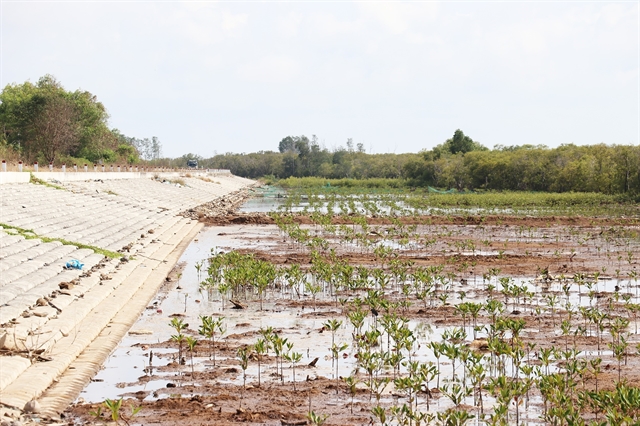 Environment
Environment

 |
| People in Vĩnh Long Province struggled to get through a flooded street due to high tides. — VNA/VNS Photo Lê Thúy Hằng |
HCM CITY — The Mekong (Cửu Long) Delta has seen significant strides in urban development, yet the increasing climate change risks mean long-term and practical strategies must be put in place for sustainable growth.
The delta currently has 211 urban areas, with an urbanisation rate of 32 per cent against that of the country at 40.5 per cent. These figures are predicted to rise in the near future.
The region is also witnessing faster sea level rise than forecast, with extreme weather phenomena that affect people’s livelihoods.
The sea level is predicted to rise by 0.5 to one metre at the end of the 21st century.
All 13 cities and provinces of the delta are at high risk of flooding due to climate change, particularly 80 per cent for Kiên Giang and Hậu Giang provinces, 40 to 50 per cent for Bạc Liêu and Cà Mau provinces, and 25 to 30 per cent for Sóc Trăng Province.
According to the deputy director of the Urban Development Agency (under the Ministry of Construction) Trần Thị Lan Anh, a third of the Mekong Delta will be submerged under water, the biggest land loss rate in the world.
Without appropriate climate change adaptation, around 35 per cent of the delta population and 39 per cent of its total area will be affected.
Anh said that the use of water resources upstream, particularly with the construction of hydroelectric dams, has altered the Mekong River flow and affected the region’s socio-economic development.
Meanwhile, bustling economic activities within the region are also the reason for pollution, erosion, decline in groundwater level and sea encroachment, she added.
Excessive sand and mud mining for construction along the streams increases the chances of landslides and poses risks to urban development.
Nguyễn Đức Hiển, deputy head of the Central Economic Commission also said that local authorities’ responsibilities overlap with limited coordination.
At the same time, development planning for regional socio-economic context, sectors and localities is not fully aligned, especially with HCM City, the key economic zone in the south and the Mekong sub-region.
The mobilisation and use of resources for growth investment also remains modest, Hiển said.
Adaptation strategies
Dr Hồ Công Đức from Vietnam University of Commerce said that urban planning is one of the key factors in mitigating climate change impacts in these areas.
The Poliburo’s Resolution 06 in 2022 on planning, construction, management and sustainable development of Việt Nam’s urban areas by 2030, with a vision to 2045, set the ambition to develop a balanced, comprehensive urban network aiming toward green, smart cities that are able to adapt to climate change and weather phenomena.
The Prime Minister also issued a decision on Mekong Delta planning for the 2021-2030 period with a vision to 2050, which said that the region will have an urbanisation rate of around 42 to 48 per cent by 2030.
The Urban Development Agency deputy head Anh said that a growth model of urban and rural systems is necessary for climate change adaptation in the Mekong Delta.
The focus of this model is to proactively “make room for water”, ensuring the balance in the ecosystem and the structures of existing rivers, canals and streams.
The land lots selected for urban development and residential areas must also take into account climate change risks and sea level rise, as well as the natural topographical structure of the locations.
One approach to urban growth in these areas is to switch from “adapt to floods” to “actively adapt to floods, inundation and brackish and saline water” based on comprehensive water resources planning, ensuring fresh water supply for local residents.
Anh said that sustainable urban development needs to take into account the spatial structure of the region, particularly the decrease of low flows and how they affect the waterways, which will in turn impact traffic planning.
A control system for urban flooding should also be put in place, including detention basins, drainage routes and embankments, in addition to relocating residences at risk and developing flood and storm resistant constructions.
 |
| Tiền Giang Province has invested VNĐ56.2 billion (US$2.3 million) into mangrove planting to protect its Gò Công embankment from sea encroachment. — VNA/VNS Photo Hữu Chí |
Local approach
Cần Thơ City has identified key functional areas for water utilisation, as well as buffer zones for natural infiltration capacity.
These areas are closely linked to one another to form a water supply chain for the city, contributing to its urban agriculture.
The Politburo in Decision No 59–NQ/TW issued in 2020 also set the goals for Cần Thơ to become an ecological and modern city, a centre of trade, tourism, logistics, high-tech agriculture, education, healthcare, science-technology, sports and culture of the Mekong Delta.
Meanwhile, Hậu Giang Province, whose two cities Vị Thanh and Ngã Bày have an inundation risk of 85-90 per cent, determined that its strategy is a rapid and sustainable urban growth that also adapts to climate change.
According to the provincial People’s Committee chairman Đồng Văn Thanh, the locality has put in place tools and methods for climate change impact forecasting in its urban development.
Hậu Giang has also submitted a proposal, which has been approved by the Prime Minister, on developing Ngã Bảy City into a green urban area that can adapt to climate change.
The total investment for the project, scheduled for 2023 to 2026, is estimated at VNĐ1.2 trillion (US$49.7 million) from the province’s budget, in addition to loans from the French Development Agency (AFD).
Vietnam University of Commerce’s Dr Hồ Công Đức believed that sustainable urban development required specific regulations on construction.
The focus needs to be put on the urban ecosystem and green areas in alignment with population growth and construction density, alongside maintaining detention basins and reducing concrete surfaces for better open spaces.
In addition to relocating residential at risk of flooding, erosion and high tides, it is also necessary to improve water drainage and treatment systems in urban areas, he said.
For coastal cities in particular, Đức believed that localities must take action to plant more trees for protection against storms, coastal erosion and tide-induced flooding.
Eco-friendly construction materials are also recommended to reduce greenhouse effects and withstand climate change impacts, he added. — VNS




